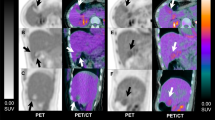Abstract
Background
Prior to interpreting PET/CT, it is crucial to understand the normal biodistribution of fluorodeoxyglucose (FDG). It is also important to realize that the normal biodistribution can vary between adults and children. Although many studies have defined normal patterns of pediatric FDG uptake in structures like the thymus, brown fat and bone marrow, patterns of normal pediatric bowel activity, specifically uptake within the appendix, have not been well described. Active lymphoid tissue has increased FDG uptake when compared with inactive tissue. Since children have more active lymphoid tissue than adults, and because the appendix contains aggregated lymphoid tissue, we postulated that appendiceal uptake may be increased in pediatric patients.
Objective
To define the normal level of appendiceal FDG activity in children by evaluating a series of consecutive FDG PET/CT scans performed for other indications.
Materials and methods
After obtaining IRB approval, we retrospectively reviewed 128 consecutive whole-body pediatric FDG PET/CT examinations obtained for a variety of clinical indications. CT scans on which the appendix could not be visualized were excluded from analysis. CT scans on which the appendix could be visualized were evaluated for underlying appendiceal pathology. Studies with appendiceal or periappendiceal pathology by CT criteria were excluded. A region of interest (ROI) was placed over a portion of each appendix and appendiceal maximum standardized uptake value (SUVmax) was calculated. If an adjacent loop of bowel activity interfered with accurate measurements of the appendix SUVmax, the scan was excluded from the analysis. A chart review was performed on patients with elevated appendiceal SUVmax values to ensure that the patients did not have clinical symptomatology suggestive of acute appendicitis. When the appendix or a portion of the appendix could be visualized and accurately measured, the SUVmax was determined. SUVmax of the appendix was compared to the SUVmax of normal liver and ratios were recorded.
Results
A total of 128 scans were reviewed, patient ages 1 month to 21 years (mean age: 11.6 years). Thirty-one scans were excluded because of inability to visualize the appendix on CT. No scans were excluded for appendiceal/periappendiceal pathology on CT or chart review. No scans had to be excluded for inability to obtain an accurate SUVmax measurement because measurements were calculated on portions of the appendix separate from adjacent bowel using small ROIs. Maximum appendiceal SUVs ranged from 0.5 to 9.4 (mean: 2.2) with an appendix-to-liver background ratio ranging from 0.3 to 3.1 (mean: 1.1).
Conclusion
FDG uptake in the appendix is typically similar to that of background activity. However, slight variations in appendiceal FDG uptake do occur, which should not be misinterpreted as pathological.






Similar content being viewed by others
References
Shammas A, Lim R, Charron M (2009) Pediatric FDG PET/CT: physiologic uptake, normal variants, and benign conditions. Radiographics 29:1467–1486
Alazraki A, Simoneaux S, Wyly B (2011) Normal conus medullaris FDG uptake in children. Pediatr Radiol 41:1374–1377
Prabhakar H, Sahani D, Fischman A et al (2007) Bowel hot spots at PET-CT. Radiographics 27:145–159
Jadvar H (2011) Colonic FDG uptake pattern in subjects receiving oral contrast with no known or suspected colonic disease. Clin Nucl Med 36:754–756
Toriihara A, Yoshida K, Umehara I et al (2011) Normal variants of bowel FDG uptake in dual-time-point PET/CT imaging. Ann Nucl Med 25:173–178
Israel O, Yefremov N, Bar-Shalom R et al (2005) PET/CT detection of unexpected gastrointestinal foci of 18F-FDG uptake: incidence, localization patterns, and clinical significance. J Nucl Med 46:758–762
Ogawa S, Itabashi M, Kameoka S (2009) Significance of FDG-PET in identification of diseases of the appendix – based on experience of two cases falsely positive for FDG accumulation. Case Rep Gastroenterol 3:125–130
Lu SJ, Osmany S, Khoo J et al (2010) Synchronous adenocarcinoma of the appendix demonstrated on F-18 FDG PET/CT. Clin Nucl Med 35:256–257
Koff S, Sterbis J, Davidson J et al (2006) A unique presentation of appendicitis: F-18 FDG PET/CT. Clin Nucl Med 31:704–706
Conflict of interest
None.
Author information
Authors and Affiliations
Corresponding author
Rights and permissions
About this article
Cite this article
Reavey, H.E., Alazraki, A.L. & Simoneaux, S.F. Normal patterns of 18F-FDG appendiceal uptake in children. Pediatr Radiol 44, 398–402 (2014). https://doi.org/10.1007/s00247-013-2835-6
Received:
Revised:
Accepted:
Published:
Issue Date:
DOI: https://doi.org/10.1007/s00247-013-2835-6




